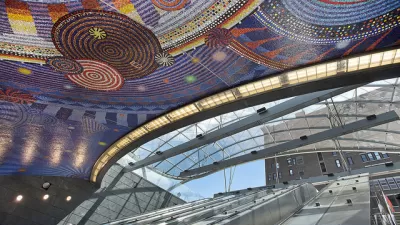Details are now just emerging about a proposal from NYC Mayor Bloomberg to further extend the IRT #7 line from the West Side station by a planned, massive new development, Hudson Yards. Cheaper than a commuter rail tunnel, it would serve NJ Transit.
The $9 billion plan to build a new set of rail tunnels under the Hudson River from NJ to NYC, known as Access to the Region's Core (ARC), came to an abrupt halt Oct. 27 when NJ Gov. Chris Christie pulled the plug on account of his concern that his state would be responsible for what he projected to be massive cost overruns.
"The NYC plan envisions the No. 7 stretching from 34th Street on the Far West Side of Manhattan to Secaucus, N.J., where there is a connection to New Jersey Transit trains.
It would do so at about half the cost, an estimated $5.3 billion, according to a closely guarded, four-page memorandum circulated by the city's Hudson Yards Development Corporation. And the project would almost certainly serve as a boon for the planned $15 billion Hudson Yards residential and office development, to be built on platforms over the West Side railyards."
No word from DOT Secretary Ray LaHood on the project proposal, perhaps that's because he's busy "wrangling with New Jersey to repay $271 million the federal government has spent on the project."
From Hudson Yards Development Corporation website:"Key components of the development program (include) the extension of the No. 7 subway line from its current terminus at Times Square to a new terminal station at 34th Street and 11th Avenue."
If the project is clearly viable as opposed to a trial balloon, it would also have to compete with a possible Amtrak proposal, which might be viewed more favorably by both Secretary LaHood as it would be high speed rail- capable, and the incoming presumptive chair of the House Transportation and Infrastructure Committee, John Mica (R-FL).
Thanks to Kenyon Karl
FULL STORY: Take the No. 7 to Secaucus? That’s a Plan

Study: Maui’s Plan to Convert Vacation Rentals to Long-Term Housing Could Cause Nearly $1 Billion Economic Loss
The plan would reduce visitor accommodation by 25,% resulting in 1,900 jobs lost.

North Texas Transit Leaders Tout Benefits of TOD for Growing Region
At a summit focused on transit-oriented development, policymakers discussed how North Texas’ expanded light rail system can serve as a tool for economic growth.

Why Should We Subsidize Public Transportation?
Many public transit agencies face financial stress due to rising costs, declining fare revenue, and declining subsidies. Transit advocates must provide a strong business case for increasing public transit funding.

How to Make US Trains Faster
Changes to boarding platforms and a switch to electric trains could improve U.S. passenger rail service without the added cost of high-speed rail.

Columbia’s Revitalized ‘Loop’ Is a Hub for Local Entrepreneurs
A focus on small businesses is helping a commercial corridor in Columbia, Missouri thrive.

Invasive Insect Threatens Minnesota’s Ash Forests
The Emerald Ash Borer is a rapidly spreading invasive pest threatening Minnesota’s ash trees, and homeowners are encouraged to plant diverse replacement species, avoid moving ash firewood, and monitor for signs of infestation.
Urban Design for Planners 1: Software Tools
This six-course series explores essential urban design concepts using open source software and equips planners with the tools they need to participate fully in the urban design process.
Planning for Universal Design
Learn the tools for implementing Universal Design in planning regulations.
City of Santa Clarita
Ascent Environmental
Institute for Housing and Urban Development Studies (IHS)
City of Grandview
Harvard GSD Executive Education
Toledo-Lucas County Plan Commissions
Salt Lake City
NYU Wagner Graduate School of Public Service




























